Leica X Vario: Characteristics
On this page, I would like to discuss the specific characteristics that lead me to buy the Leica X Vario - except for one, the lens, which I cover on another page.
Furthermore, I present those characteristics that drive me crazy on the pages Design Issues and Functional Issues (on another page I present a few "tips and tricks" that help me overcome some of the X Vario's shortcomings - or allow me to work with it even "smoother.")
In addition to the characteristics, I present a few optional accessories for the Leica X Vario that I have bought. Initially, I had presented these here, but since they cannot be subsumed under "the specific characteristics that lead me to buy the Leica X Vario," I decided to present them on a separate page.
Note: For a functional comparison with the Ricoh GXR A16 see page Leica X Vario and Ricoh GXR A16: Technical and Functional Comparison.
It's A Leica - Albeit not a "Real" One
"It's a Leica" - can this really be an argument for buying one? Am I kidding? Yes and no... No, because, as I wrote on the start page, I had declared in January that I would buy a Leica this year (2013) - a statement made because of frustration with Ricoh's attitude towards it's GXR camera. My first idea was to buy a Leica M240. However, there were several reasons that prevented me from buying it such as it's steep price tag and, probably even more so, that it was not available (I do not no when people who did not preorder will be able to buy one...). And when I handled an M9 in a shop in late January 2013, I was admittedly not much convinced of the M...
Having bought the Ricoh GXR M-mount expansion unit and a number of M-mount lenses, I was interested in buying a "poor man's Leica" like the GXR, however, a full format one. When the Leica X Vario was announced in May 2013 or so, many photographers, including me, hoped that this "Mini M," as Leica dubbed it, would be something like that. As we all know in the meantime, this was not the case: The X Vario was an extension of Leica's X series with a fixed zoom lens - and some cosmetic changes that make it look more similar to the M series. A shit storm went down on the camera, and only a few users dared to disclose that they had bought it. Since July 2013, I am one of them. Now I owned a Leica at only about the third of the cost of a Leica M240 - but it was still expensive enough...
This Leica model, the X Vario, is not a "real" Leica because is neither has a rangefinder nor can you exchange lenses. Why did I buy it despite these "shortcomings"? What makes it nevertheless specifically Leica? Here is a lose list of arguments:
- Leica cameras are simple and lack many of the complex features of Nikons, Canons, Ricohs, and so on. Actually, it was the simplicity of operation and in functionality (or lack of it...) that attracted me. Back to the roots of photography - at least to some degree (even a Leica is a computer these days...)!
- Some users maintain that the X Vario's lens equals in quality - or is even better - than some genuine Leica M-mount lenses. I cannot judge this and have to wait for the proof of the pudding... In this vein, some users also state that the X Vario is like a Leica M body with four prime lenses: 28 mm, 35 mm, 50 mm, 70 mm - and in between (Mike Evans calls it a "Quad-Elmar"). This makes up for a much more compact and lighter package than having to carry around a Leica M with four primes... (Actually, 28-70 mm is not an impressive zoom range, but Leica maintains that it satisfies 90% of the "normal" shooting needs. Whether this is true probably depends on your personal shooting habits - I would not subscribe to Leica's statement in my case...)
- I was never interested in using the rangefinder of the Leica M. If I would ever have bought an M240, I probably would have used it exclusively with an electronic viewfinder (real Leica users will now turn away with disgust...). Thus, the X Vario's lack of a rangefinder did not bother me at all (only the fact that Leica does not open it up to the new Olympus viewfinder...).
- As a member of the X series, the X Vario carries the label "Made in Germany." Thus, it is not a Panasonic-made Leica. No one knows (outside of Leica) how many genuine "German" parts are built into this camera, but at least, it is assembled in Germany. Anyway, a camera "made in Germany" for someone who lives there - that seems like a dream these days...
Two more things may or may not be typical for Leica, albeit they might be counted among the reasons not to buy a Leica: Leica's unwillingness to answer to customer emails, and its "slow or never" firmware update policy... But I learned about these things only "after the fact"...
"Mechanical" Handling
The most compelling reason for me to buy the Leica X Vario was its "outdated" interaction style: Zoom range, distance, shutter speed, and aperture can all be set using dials and rings (see my discussion below). You can see this best when looking at the camera from above (see Figure 1).
Setting Focus and Focal Length
The lens has both a focus ring and a zoom ring. If you turn the focus ring to the left and beyond a "click", focus is set to automatic (AF; see Figure 1). The zoom ring has labels for the "classic" focal lengths of 28, 35, 50 and 70 mm (equivalent). The lens has therefore been named a "Quad-Elmar" (by Mike Evans). Note that there are no depth of field indicators on the lens. (See my pages about hyperfocal distances and depth of field tables for more information on this.)
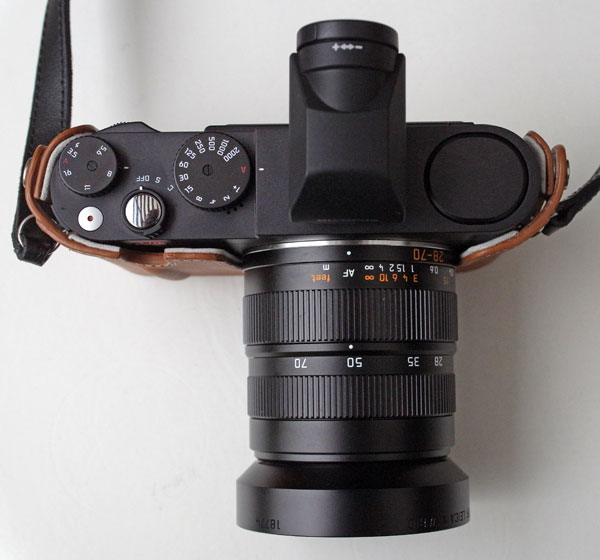
Figure 1: Leica X Vario seen from above; on the top plate there are the wheels for setting aperture and shutter speed; the lens has two rings for setting distance and focal length
Setting Exposure Modes
Exposure modes can be set using the shutter speed dial and the aperture dial. Thus, there is no mode dial for setting PASM modes (or with other labels). Figure 2 shows how you can use the different modes:
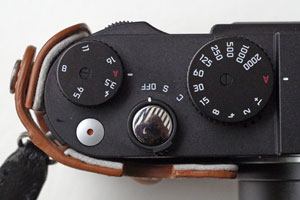 |
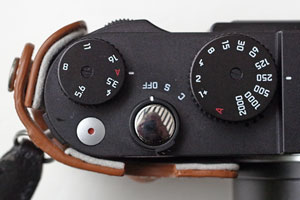 |
|
Automatic program |
Shutter speed priority |
|
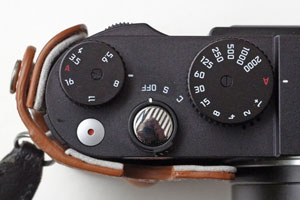 |
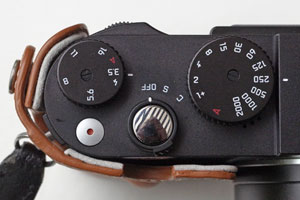 |
|
Aperture priority |
Manual setting |
Figure 2: Setting the different exposure modes on the Leica X Vario using two dials for aperture and shutter speed
Setting the exposure mode, pre-focusing or setting the focus mode, and pre-zooming, can be done when the camera is turned off. This saves me a lot of time and does not drain the battery, because, before turning the camera on, I can already check and potentially change settings.
Focus and Zoom: Mechanical or Not?
Note that although focusing feels "mechanically," it actually seems to be "by wire" and is done using a step motor - at least, this is what I have read about it. The step motor moves only one lens element to make automatic focusing faster. Despite of the "by wire" technique employed, you can pre-set distance to a certain value when the camera is turned off. When you turn the camera on, it takes more than a second before you can see something in the viewfinder - time enough to adjust the focus accordingly via a step motor.
For the zoom ring, I am not sure - it looks as if there is a combination of mechanical and "by wire" in place. When I move the zoom ring quickly to and fro, I can hear noises, sometimes even a "clack" noise that sounds a little bit disturbing - one hint that the zoom might be "by wire." On the other hand, you can zoom when the camera is turned off (however, you cannot see the result...), indicated by the fact that the length of the lens changes accordingly. Perhaps others will find out what the camera eventually does...
Conclusions
The Leica X Vario's handling style is simple and direct. And that is why it encourages me to interfere with what the camera usually does automatically and use other modes than program mode and manual instead of autofocus. I am really amazed how simple and easy the Leica X Vario approach is. However, this does not mean that I would not make any mistakes. For example, I tend to overlook that I set the camera to manual focusing and, of course, to the wrong distance for the respective motive... But that is my fault, not the camera's.
Other settings that I change fairly often are exposure compensation and ISO. Both are accessible via buttons on the camera back, and therefore still direct enough for me (although I would not mind having them on dedicated buttons that indicate the current setting...).
While setting focus at the lens appears to be mechanical, it is in fact "by wire." But it is so well implemented that it nearly feels as if there were a mechanical coupling. For me, this difference is negligible so that the X Vario's handling appears to me like that of an old "mechanical" camera. What happens when one is zooming is still an open question...
The Lens
The lens is often the most prominent argument in favor of the Leica X Vario. Actually, there is so much to say about it that I will devote an extra page to it. Above, I mentioned already that some users maintain that the X Vario's lens equals in quality - or is even better - than some genuine Leica M-mount lenses. In this vein, some users also state that the X Vario is like a Leica M body with four prime lenses: 28 mm, 35 mm, 50 mm, 70 mm - and in between (Mike Evans calls it a "Quad-Elmar"). This would make up for a much more compact, lighter, and cheaper package than having to carry around a Leica M with four primes. Leica also maintains that the X Vario's lens satisfies 90% of the "normal" shooting needs.
On my "lens" page, I present some technical data and investigate what others think about the lens, what test results say, and what my opinion on the lens is.
The Body
The Leica X Vario is based on previous X series cameras, particularly on the Leica X2. However, Leica made some cosmetic changes to the design that make the X Vario look more like a "small" Leica M. Many users welcomed this design change and some even proclaim that the X Vario is one of the most beautiful cameras on the market.
I do not think that the X Vario is ugly - admittedly I like its look. However, there are some design issues that could, in my opinion, have been avoided. See my page Design Issues on my take in this respect.
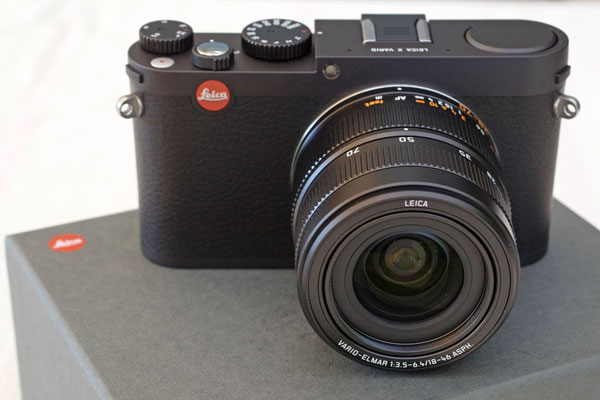
Figure: The "pure" Leica X Vario
One should also note that despite being a member of Leica's "compact" camera's group, the X Vario is neither small nor lightweight. It does not easily fit a pocket, and its real-world weight is about 760 g in my case (with EVF and protector, see figure below) - quite heavy when I carry it with the shoulder strap around my neck.
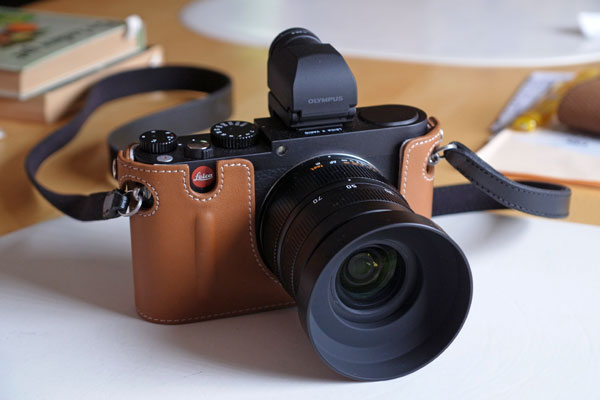
Figure: Leica X Vario with Protector, Olympus VF2-electronic viewfinder, lens hood and shoulder strap
| 03.04.2019 |